BriarTek ORCADSC ORCA DSC Personal Locator Beacon FCC Certification User Manual ORCA DSC User guide DRAFT
BriarTek Inc. ORCA DSC Personal Locator Beacon FCC Certification ORCA DSC User guide DRAFT
BriarTek >
User Guide
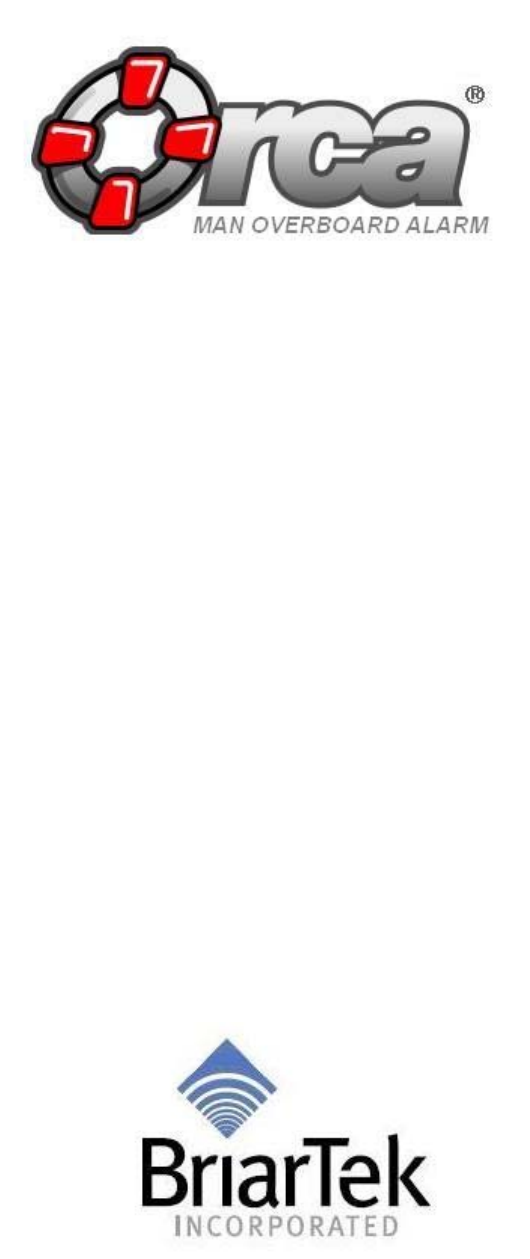
Overboard Recovery
Communications Apparatus
(ORCA®)
ORCA DSC User’s Guide

2
BriarTek, Inc. Technical Support: (703) 548-7892, Email: support@briartek.com, URL: www.briartek.com
©2009 BriarTek Incorporated
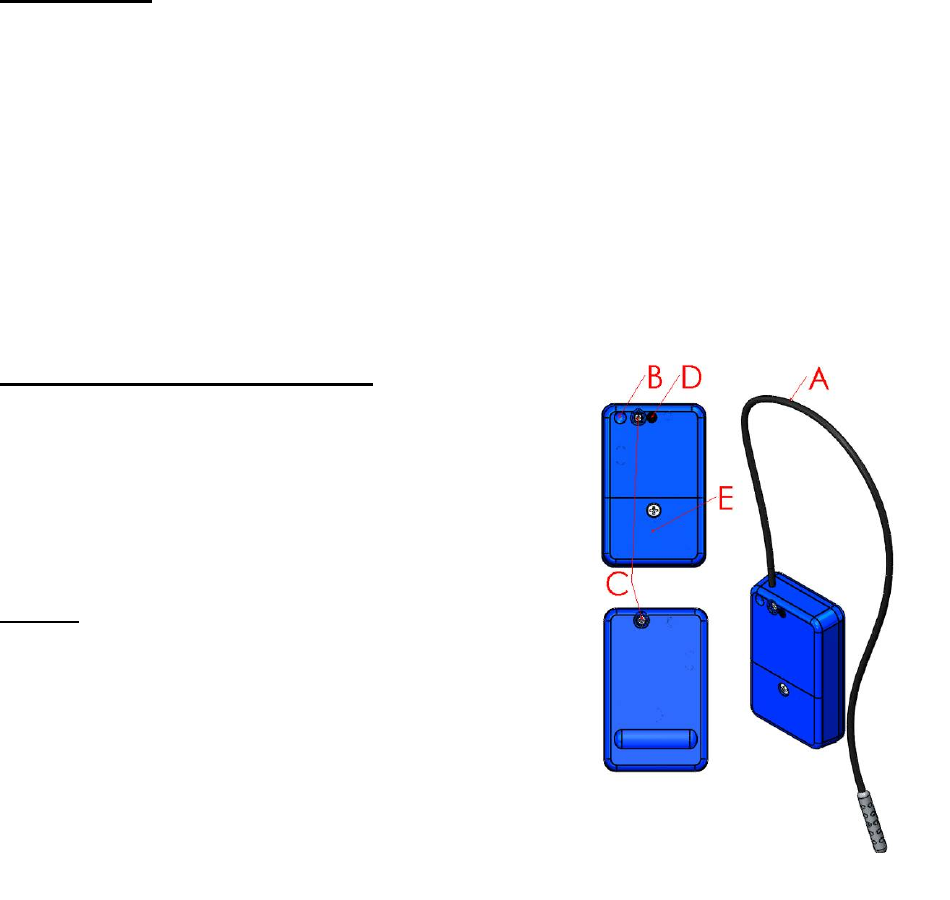
3
Figure: 1
Introduction
ORCA® is a personal saltwater or manual-activated man overboard (MOB) alarm system
developed by BriarTek Inc. The system is utilized by the U.S. Navy and other mariners to aid in
the rescue of an MOB victim and includes a transmitter, receiver, and direction finder. The
ORCA® DSC transmitter alerts a MOB event on VHF marine channel 70 and 121.5 MHz. When
the transmitter is activated, it transmits a digital selective calling (DSC) distress message on VHF
marine channel 70 from the victim to any vessel operating with a DSC complaint VHF marine
radio. ORCA® DSC also transmits a distress message to an ORCA® receiver on 121.5 MHz
during a MOB event. The receiver emits an audible alarm and displays the ship type/hull number
and serial number of the transmitter on the ORCA® receiver’s LCD. The transmitter also emits a
signal that is received by the direction finder and other standard search and rescue (SAR)
equipment to locate the MOB.
ORCA® DSC Parts Overview (See figure 1)
A - Antenna
B - Manual activation/ deactivation recess
C - Water sensors
D - Distress marker light (DML)
E – Battery door
Modes
The ORCA® DSC has three modes:
♦ ARMED - Each transmitter is ARMED after
a 3 volt CR123 lithium battery is correctly
installed.
♦ TRANSMIT - The transmitter goes from
ARMED to TRANSMIT mode when it is
automatically activated by submerging it in
saltwater for a minimum of 3 seconds or
when it is manually activated. After the
transmitter is activated, it emits a DSC
message on VHF marine channel 70 per the ITU-R M.493-11 protocol to its registered
VHF marine radio. It repeats this message every five minutes for 30 minutes. If the unit
has not been turned off after 30 minutes, it will then transmit a group distress message to
DSC equipped radios within range of the transmitter. The unit also transmits a FM distress
signal at 121.5MHZ after the initial DSC transmission. This sends the transmitter
identification to the ORCA® receiver. After sending this FM distress message for
approximately 1 minute, the transmitter switches to a non-data transmission for 40
seconds. This allows the DF to track the transmitter more effectively. After every 40
second non-data transmission, the unit transmits identification information to the ORCA®
receiver for 9-15 seconds.
♦ DISABLED - The transmitter is DISABLED when the battery is removed or the battery
runs out.
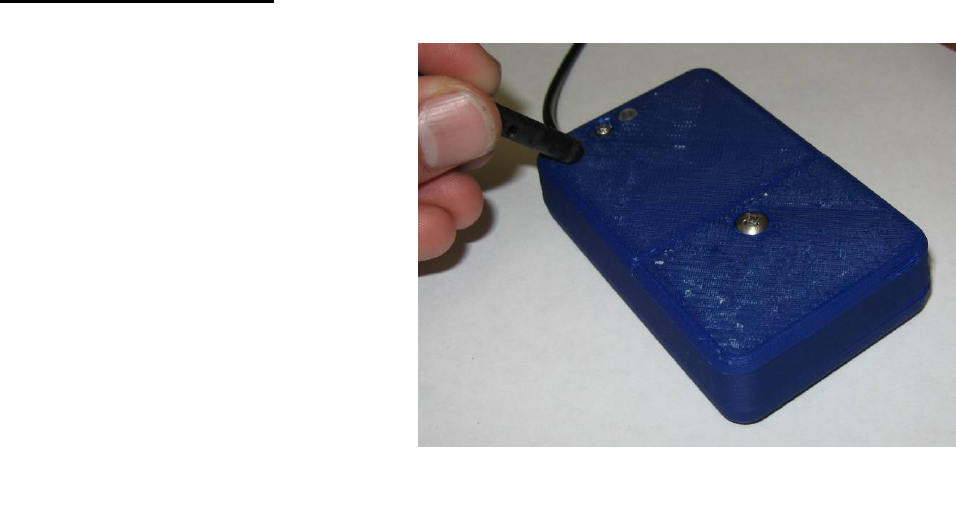
4
Figure: 2
Operating Instructions
Manual activation:
Align antenna tip (A) with manual
activation/deactivation recess (B) for
approximately 3 seconds until the DML
begins flashing rapidly. See figures 1&
2.
After the DML begins flashing, remove
antenna tip for activation/deactivation
recess. Approximately 3-5 seconds after
the DML begins flashing, the transmitter
will begin transmitting a distress
message.
Automatic activation: The transmitter
will activate when the water sensors are
submerged in saltwater for at least 3 seconds.
All Clear (deactivate transmitter): When the MOB is recovered, align the antenna tip with the
manual activation/deactivation recess for approximately 3 seconds. This disables the DSC
transmission, sends an ALL CLEAR message to the ORCA® receiver and returns the transmitter
to the ARMED mode.
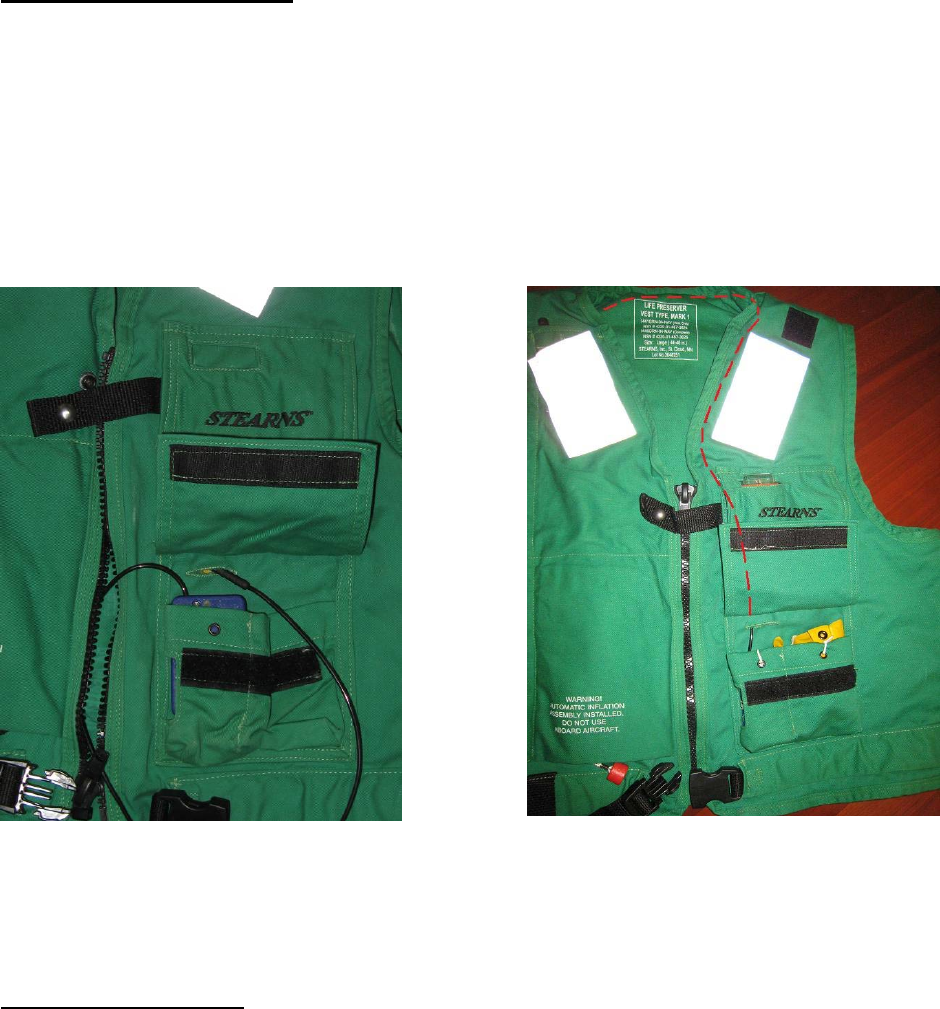
5
Figure: 3
Wearing the transmitter
THE TRANSMITTER MUST BE WORN SO THAT THE WATER SENSORS ARE
UNDER WATER AND WET AND THE ANTENNA IS ABOVE THE WATER SURFACE
WHEN THE PERSON IS FLOATING.
The following is the recommended method for wearing the transmitter on the MK-1.
- Insert transmitter into MK-1 pocket adjacent to the sea dye marker pocket. See figure 3.
Finally, insert antenna in hole under pocket flap and through channels sewn into the liner of
the MK-1. Figure 4 shows the ORCA® DSC inserted in the pocket and the dotted red line
shows the route of the antenna inside the jacket.
Important: Do not coil antenna as this will degrade the transmission signal.
Battery Information
Battery Lifespan: The ORCA® DSC has very low current consumption. It is recommended that
the battery should be replaced once a year and sooner if the ORCA® DSC has been activated for
more than occasional testing. When the ORCA® DSC is in TRANSMIT mode, a new battery will
last approximately 24 hours.
Use the following steps to test the battery strength:
1. Activate the unit by aligning the antenna tip with the manual activation/ deactivation
recess.
Figure: 4
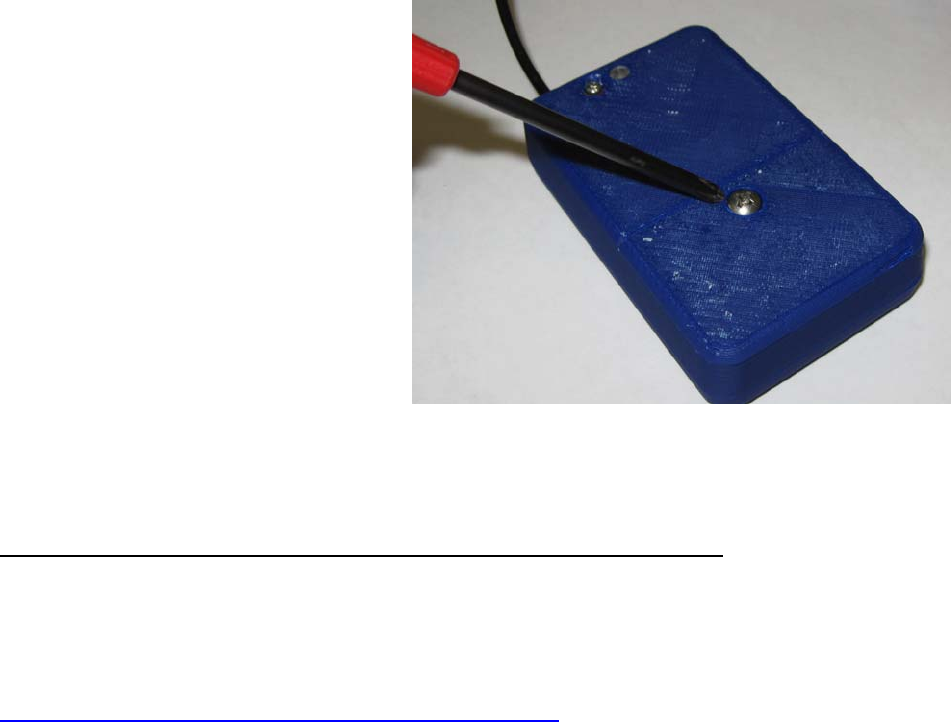
6
Figure: 5
2. As soon as the DML begins to flash rapidly, remove the antenna tip at least 1” from the
recess. Then realign the antenna tip with the manual activation/ deactivation recess once
again for approximately 3 seconds.
3. If the light turns on and remains on solid for approximately 3 seconds, the battery is
useable. If, instead, the DML flashes on and off at this point, the battery is not useable and
must be replaced.
Use the following steps to replace the
battery:
1. Using a #1 size Phillips head
screwdriver, unscrew the
crosshead screw on the battery
door. See figure 5.
2. Remove battery door.
3. Remove used battery.
4. Insert new 3 volt CR123 lithium
battery according to polarity
diagram on the inside of the
battery door.
5. Replace battery door. Grasping
screwdriver with thumb and
forefinger, screw down the
battery door to 45 in/oz.
6. Do not over tighten!
DSC Maritime Mobile Service Identity (MMSI) Registration
Each DSC transmitter should be programmed to operate with the owner’s registered DSC capable
VHF marine radio. The registration number, known as the VHF marine radio’s MMSI number, is
a unique 9-digit identification number that can only be supplied by the United States Coast Guard
and its affiliated MMSI registration partners. More information regarding MMSI registration for
VHF marine radios may be found at the following Internet address:
http://www.navcen.uscg.gov/marcomms/gmdss/mmsi.htm
The digital selective calling feature of an ORCA® DSC beacon, by default, will transmit a generic
MMSI number that is not registered to any VHF marine radio. The owner’s registered MMSI
number can be programmed at the factory or at an approved reseller’s facility.
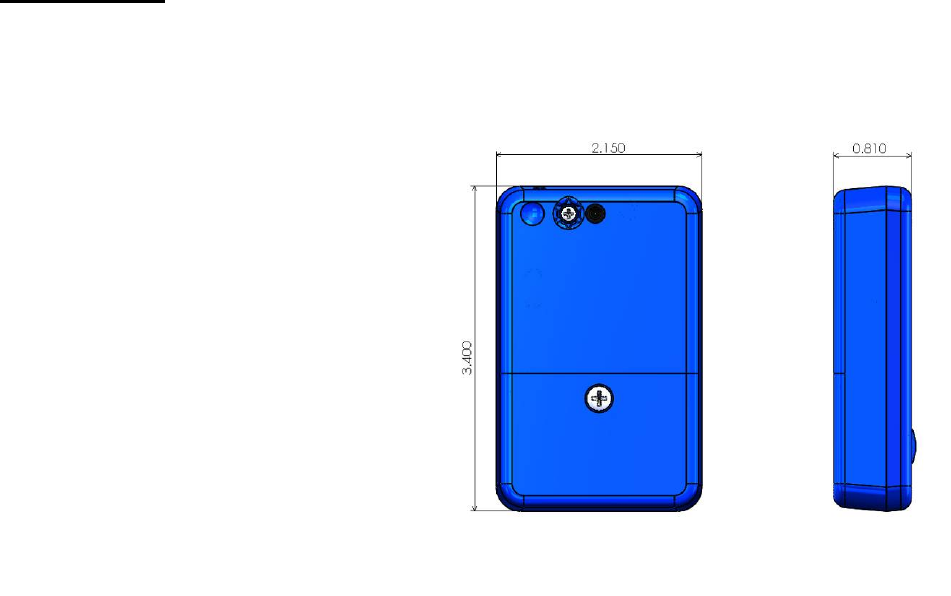
7
Specifications
♦ Size: length = 3.4 inches x width = 2.15 inches x depth = 0.81 inches.
♦ Weight: 2.5 oz. (70.9 g)
♦ Power: 156.525MHz = 100 mW;
121.5MHz = 100mW
♦ Tracking Range: 2 NM from small
craft, 5 NM from ship, 20 NM or
greater from aircraft
♦ Alerting Range: 1 NM to receiver
♦ Power Source: One (1) 3 volt CR123
lithium battery
♦ Battery Life: One year (Armed
mode); 24 hours continuous once
activated (Transmit mode)
♦ Activation: manual or saltwater
♦ Current Draw: Armed 21 uA;
Transmit (DSC): 125mA; Transmit
(high power): 200mA; Transmit
(low power): 100mA
♦ Modulation Frequency: 121.5 MHz
& 156.525MHz
♦ 25.5 inch (64.75 cm) external
antenna with strain relief (the length can be modified based on user needs)
♦ Operating Temperature -20º C (-4º F) to +55º C (131º F)
♦ Storage Temperature -40º C (-40º F) to +85º C (185 º F)
8
Warranty
BriarTek will provide a one-year warranty on the ORCA® man overboard alarm system
following the purchase date.
If a component fails to function properly during its warranty period (one year), the
manufacturer will proceed according to its warranty as follows:
BriarTek Inc. guarantees each product it distributes to be free from defective materials and
workmanship and agrees to remedy any such defect, or to furnish a new or equal part in
exchange (at its option) for a period of one year from the date the component is purchased.
For an exchange of the product, carefully pack the equipment and return to BriarTek Inc. at the
following address: BriarTek Inc.
3129 Mt. Vernon Ave.
Alexandria, VA 22305
This warranty is void if:
♦ any component has been subject to misuse or improper installation by a non-BriarTek
employee, or has been repaired or altered by a non-BriarTek employee.
♦ any component fails to function properly after being put into service due to something
other than defective materials or workmanship, i.e. excessive temperature, humidity or
shock while component is in storage.

9
Notes: